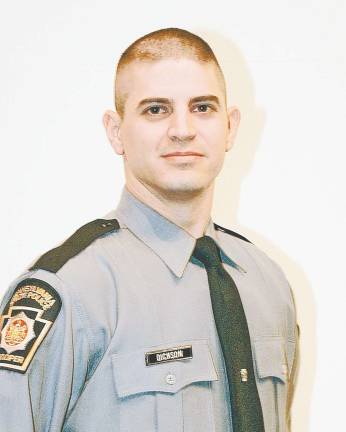Trooper's autopsy wraps up testimony in ambush case

By Marilyn Rosenthal
MILFORD — Two expert witnesses gave testimony on the fallen trooper's autopsy as the evidentiary phase of the Eric Frein trial approached its final day.
The jury on Tuesday saw photos of Cpl. Bryon Dickson II taken after his death by Cpl. Joseph Parisi, a forensic autopsy photographer. They showed Dickson fully dressed and then with his clothes removed, on his left side and then on his right.
Photos of his hands showed no marks that might have been made in self-defense.
Dickson had two bullet wounds: one bullet entered the right side of his upper chest and exited through his back. The exit wounds were much larger than the entrance wounds because the bullets tumbled through the body, Parisi said.
The second bullet entered Dickson's right shoulder and exited through his left shoulder. Dickson was wearing a bullet-proof vest not designed to protect against a rifle shot or knife. He was shot with a rifle. The bullet entered above the "trauma plate" — a metal plate about the size of a Kindle — on the inside of the vest.
Parisi was working in the Northeast Forensic center in Lackawanna County when he was called to collect evidence and photograph procedures during Dickson's autopsy. Photographs are taken before, during, and after the autopsy to provide context, Parisi explained.
Dr. Gary Ross, a forensic pathologist with more than 30 years of experience performing autopsies, explained that the procedure is to investigate the cause of death. He first gathered as much information as he could about the circumstances surrounding Dickson's death to determine its cause, and to rule out suicide or accident.
Like Parisi, Ross saw the body in the state it was found. He removed the clothes, washed the body, and began an internal exam to determine the extent of the damage.
Because of the internal damage caused by the bullets, either of the two wounds Dickson sustained would have been enough to kill him because he would have bled to death. He also determined that Dickson was awake and conscious in the time before he died, although he could not speak.
On a human-sized fully dressed mannequin wearing Dickson's clothes, including his undershirt, his shirt, his pants, and his protective vest. Ross inserted plastic rods in the mannequin to show where the bullets entered.
He delivered his final opinion in a very somber tone:
Cause of death: Multiple gunshot wounds.
Manner of death: This was a homicide.
With this witness, the prosecution rested its case. There was no cross-examination from the defense, which also rested its case.
'Eric Frein is a human being'Final arguments by both sides are scheduled for tomorrow in this evidentiary, or testimony, phase of the trial. The case will then go to the jury.
Even if the jury returns a guilty verdict, the trial is still not over. The penalty phase of the trial will begin, with both sides calling witnesses and arguing for and against the death penalty.
The defense is expected to present lots of mitigating factors, information about the defendant that might lead the jury to hand down a lesser charge.
Outside the courtroom, defense attorney Michael Weinstein admitted the prosecution presented a lot of what appeared to be substantial evidence.
"It's up to the jury to evaluate the evidence and to decide whether it complies with the judge's instructions on burden of proof," he said.
Why didn't the defense do more cross-examination?
"The jury is very sophisticated," Weinstein responded. "They don't want to see lawyers cross-examine just for the sake of cross–examining."
Defense Attorney Ruzzo said the team will present as many mitigating factors as they can during the penalty phase of the trial, which is expected to start on Thursday.
What do you hope the jury will understand about Frein that may not be evident yet?
Ruzzo replied, "That Eric Frein is a human being, and displays the qualities of humanity and a core of goodness that we all have."
Editor's note: The article has been updated.